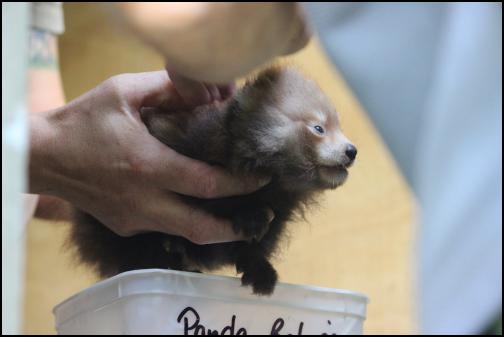Pic & Video: Three Red Panda Cubs At Hamilton Zoo

Good
things come in threes at Hamilton Zoo
11 February
2013
The birth of not one, not two but three rare Nepalese pandas has thrilled keepers at Hamilton Zoo.
The three boys, yet to be named, were an early Christmas present for the Zoo and were born on 20 December 2012.
The birth of the triplets has doubled the number of red pandas to the Zoo, taking the total up to six – mother Tayla, Father Chito and big brother Ketu who was born at the zoo in 2010.
Now seven weeks old, the three cubs are doing well and mother Tayla is doing an exceptional job.
For Zoo Curator Sam Kudeweh, the birth of the triplets late last year was great news however seeing them progress is even better.
“Red panda cubs are slow to develop so the first months are really crucial. We have been undertaking regular weigh ins with the cubs so that we can keep an eye on their progress – but need to balance this with a hands off approach as much as possible so we can leave mum Tayla to look after her cubs.”
The cubs were first weighed at 19 days old, when they were around 225 grams. They have now increased to a weight of around 400grams – nearly as heavy as a can of baked beans.
The cubs are currently in the den with their mother, where they are expected to spend up to around three months before venturing out to the public space.
For Ms Kudeweh, the birth of the pandas is really important for Hamilton Zoo.
“Red pandas are one of the few species with a global captive breeding programme, which Hamilton Zoo is proud to be part of. We are really pleased to be able to contribute to the survival of the species with this breeding opportunity,” she said.
About red
pandas
Looking more like a racoon than a giant
panda, the red panda has striking chestnut fur, bellies and
limbs are black, a bushy, striped tail and a white face.
They are a lot smaller than giant pandas, only reaching
50-60cm in body length and weighing 3-5kg.
Red pandas are found throughout the Himalayan ranges, in Western China, Nepal, Bhutan, Myanmar and India. They live in the same habitat as the giant panda, with both species having evolved to almost exclusively eat bamboo leaves and occasionally fruit, small animals, eggs and roots.
Classified as ‘vulnerable’ by the IUCN, the population of red pandas is thought to be less than 10,000 and decreasing. Deforestation and habitat fragmentation are the main threats to the survival of the species, and poaching for their beautiful fur is a major problem in China, where pelts have cultural significance.
ENDS


 Gordon Campbell: On Why We Can’t Survive Two More Years Of This
Gordon Campbell: On Why We Can’t Survive Two More Years Of This Peace Action Ōtautahi: Bridge Of Remembrance Peace Protest
Peace Action Ōtautahi: Bridge Of Remembrance Peace Protest National Wetland Trust: Public Asked To Help Prevent Fires In Wetlands This Summer
National Wetland Trust: Public Asked To Help Prevent Fires In Wetlands This Summer Lillian Hanly, RNZ: The Year In Politics - Stories That Dominated The Headlines In 2024
Lillian Hanly, RNZ: The Year In Politics - Stories That Dominated The Headlines In 2024 Waikato Regional Council: Studies Open Door To Mercury Islands Underwater World
Waikato Regional Council: Studies Open Door To Mercury Islands Underwater World Office of the Privacy Commissioner: Christmas Is About Giving, But Don’t Give Up Your Privacy
Office of the Privacy Commissioner: Christmas Is About Giving, But Don’t Give Up Your Privacy The Rail Advocacy Collective: Chris Trotter - Running Us Off The Rails
The Rail Advocacy Collective: Chris Trotter - Running Us Off The Rails


